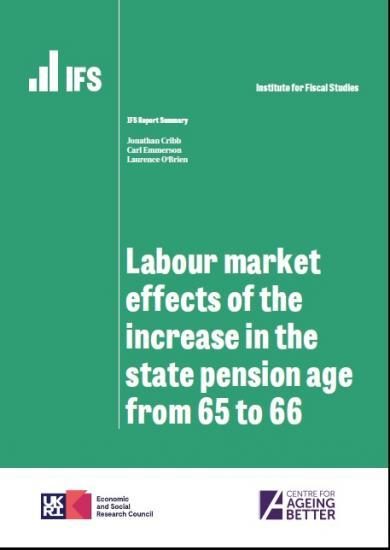Labour Market Effects Of The Increase In The State Pension Age From 65 To 66
25th January 2022

The Institute for Fiscal Studies in report out today sets out what has happened since changing the age of retirement to 66.
The age at which people can claim a state pension (‘the state pension age', SPA) in the UK has been rising in recent years, most recently with an increase for both men and women from 65 to 66 between December 2018 and October 2020. This research analyses how employment decisions have been affected by the increase in the state pension age to 66 and will, in particular, be crucial evidence for Baroness Neville-Rolfe as she conducts the second independent review of the state pension age for the Department for Work and Pensions.
Key findings
The state pension age for both men and women increased from 65 to 66 between December 2018 and October 2020. We find this increased the employment rate of 65-year-old men by 7.4 percentage points and of 65-year-old women by 8.5 percentage points. This meant that in 2021 there were 25,000 more men and 30,000 more women of this age in employment than would have been the case had the state pension age remained at 65.
These are significant increases in employment, and especially so given that there is generally a limited financial incentive in the UK to retire at the state pension age compared with many other countries, as one is able to combine receiving a state pension with continuing in paid work without any penalty. By mid 2021, 42% of 65-year-old men and 31% of 65-year-old women were in paid work, both higher rates than at any point since at least the mid 1970s (and for women very likely to be an all-time record). The increase in employment for this age group caused by the policy over just two years (2018 to 2020) was of a similar magnitude to the gradual increase seen among 65-year-olds over the twelve years from 2005 to 2017.
The increase in employment resulting from the higher state pension age is due to people staying in their existing job for longer, rather than to those in work moving to a different employer or those not in paid work returning to the labour market. It is predominantly due to increases in full-time work rather than part-time work. For men it is disproportionately driven by the self-employed, while women working in the public sector are particularly likely to delay retirement due to the reform.
People from more deprived local areas were more likely than those living in more prosperous areas to stay in employment as a result of the increase in the state pension age to 66. Women living in the most deprived fifth of local areas in England saw their employment rate rise by 13 percentage points, compared with a 4 percentage point increase in the least deprived fifth of local areas. Consistent with this, we also find significantly larger employment responses from people with lower levels of education than from those with degree-level education. These results suggest that less advantaged people are more likely to continue to work as a result of the higher state pension age.
Those who delay their retirement as a result of the reform may in part be doing so because, faced with a loss of state pension income (which for a full single-tier pension is currently just under £180 per week), they feel that they have to continue to work to maintain their standard of living. Most of those who continue to work due to the reform are likely to be financially better off by doing so, because their extra earnings are likely to outweigh their lost pension income. That is not to say they would not have preferred to have been able to retire earlier and enjoy more leisure time. Delaying retirement may be difficult and disruptive for many, so the government should prioritise clear communication of changes to people's state pension ages well in advance.
Despite the effects of the reform on employment, it is nonetheless the case that over 90% of the population do not change whether they are in paid work at age 65 as a direct result of the policy. Indeed, the majority (6 in 10 men and 7 in 10 women) have already left the workforce before age 65.
Some people face obvious difficulties as a result of the higher state pension age, including those unemployed and searching for work at age 65. They want or need to continue working but cannot find a suitable job, and are reliant on a working-age benefit system that is much less generous than the pensioner benefit system. We estimate that an additional 5,000 65-year-olds are unemployed and seeking work as a result of the increase in the state pension age to 66. We also find that 4% of women and 3% of men aged 65 report that they are out of work for long-term health reasons (rather than being retired) as a result of the increase in the state pension age, an increase of over 25,000 people.
The evidence shows that much of the increase in employment is in full-time work, even though 20 hours of paid work at the National Living Wage would be sufficient to make up the financial shortfall from not receiving a full new state pension. This suggests there may be much as yet unmet demand from 65-year-olds for part-time work. Employers that can offer more part-time working might well be able to benefit from this.
Read and download the full report HERE 20 pages
